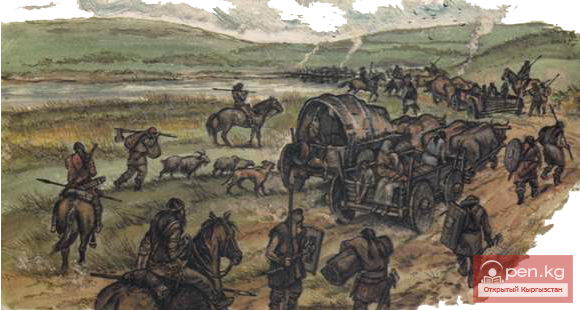
Ulus Inga-Tyuri
During military clashes, it appears that part of the "Central Asian" Kyrgyz from the right wing either migrated or was taken to the interior regions of Moghulistan and was evidently referred to as Mongols. The first mentions of them are found in written sources from the 15th century. In the "Zafarnama" (first half of the 15th century), Sharaf ad-Din Yazdi, in the account of "Timur's dispatch of troops against the Jete," these Kyrgyz were located as an elem or ulus beyond the Ili River, in Karatal. At that time, they were led by Inga-Tyuri. It is also reported that the "il and ulus" of Inga-Tyuri was caught up in the area of Kiyaz.
In the "Majmu at-Tawarikh," the genealogy of Inga-Tyuri is presented, which in the first part resembles the genealogy of the Kyrgyz from the right wing. After Anal-Hakka, Lur-khan, Guz-khan, Arslan-biya, Kuli-biya, and Mary-biya, the lineage of Anha-Tyuri is interrupted. It is likely that at this time they separated from the Kyrgyz of the right wing. Subsequently, these Kyrgyz probably rejoined the right wing of the Kyrgyz ethnicity, particularly as a tribal group known as "monoldor."
In the "Majmu at-Tawarikh," Inga-Tyuri's son was Muhammad-bek, nicknamed Kök-Buka. According to some versions of the genealogical traditions of contemporary Kyrgyz, the progenitor of the monoldor tribe (husband of Naal—the sister of Adigina and Tagai) was named Kökyo, and his nickname was Kök-buka. According to the "Majmu at-Tawarikh," the descendants of Muhammad-bek are named: Kuway (in the fourth generation), Ku-Suek (in the eighth generation), Seyid-Kazy (Gazi) (in the ninth generation). Additionally, Bai Mogol and his descendants Cholok-Tukime and Kire are also mentioned. All these names completely match (though partially distorted in the manuscript) with the names of individual progenitors and with the names of subdivisions of the monoldor tribe recorded in contemporary genealogical traditions.
The "Central Asian" Kyrgyz nomads likely changed their location from time to time depending on various reasons and circumstances, moving to different lands to some extent.
According to "Tarikh-i Rashidi" by Muhammad Haidar, the "Central Asian" Kyrgyz are mentioned in the areas of their current habitation in the early 16th century, "and the author does not mention any movements of theirs in the directly preceding period." Thus, N. N. Tumanovich writes, if during the early history of Moghulistan the Kyrgyz are not mentioned at all, then in connection with the events of the first quarter of the 16th century, they appear as the main population of Moghulistan—from the Talas valley in the west to Chalysh and Turfan in the east, from the Zailiyski steppes in the north to Kashgar in the south. Their main area of settlement was the Issyk-Kul region, but depending on various conditions, the Kyrgyz tribes moved either westward to Talas or eastward to the Turfan area. In the early 16th century, the Kyrgyz dominated the Mongol steppes, pushing the Mongols into Kashgaria. When military detachments sent by Said-khan appeared, the Kyrgyz would retreat, disperse, "and reappear in the most remote corners of Moghulistan." The "Central Asian" Kyrgyz may have moved to these lands around the second half of the 15th century. Their clashes with the Kalmyks may have contributed to this.











































